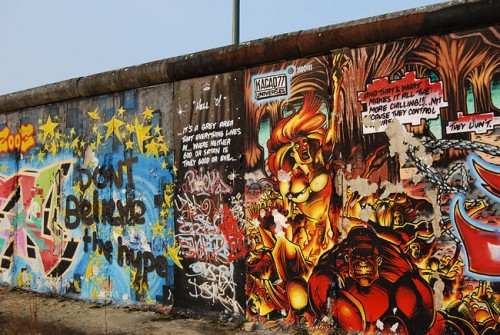 By Rajendra Shende
By Rajendra Shende
The Montreal Protocol’s entry into force gave birth to the freedom from yet another Iron Curtain.
‘Wall of Shame!’ moaned the Western proponents of freedom to describe 155 km of Berlin Wall that finally came down Nov 9, 1989. The architects of the Wall, however, called it ‘anti-fascist protection’, built to protect the population of the eastern socialists from fascist elements. The West-East divide was not just physical. It was a philosophically brutal experiment in socio-political theories.
It was not the only divide in the Cold War era. The North-South divide (developed and developing countries) characterized by scientific, technological and environmental abyss resulted in enhanced inequality between the two blocs. It created an invisible wall that was impermeable to science and technology exchanges and cooperation.
During the 1960s it was notoriously said that developed countries held their science and technology cards so close to their chest that even they could not see the cards and clasp the game they were playing. Developing countries got at least a decade old antediluvian technologies from developed nations by paying exorbitant price, if they could afford it. This game ensured that developed countries continued to sell their products with latest and efficient technologies while developing nations were left with archaic and inefficient technologies bought from their developed counterparts.
The technology transfer agreements in that era skillfully drafted by the developed countries included terms and conditions that prevented the developing nations access to the latest technologies and their further improvements. The developing bloc was either shackled with outdated technologies or, if it could, was left to develop by itself. It ensured that developed countries could easily compete in the global market.
Those companies in developing countries that bought old technologies and managed to improve it to bring to global standards, a clause in the technology transfer agreement prevented them from selling the products in the territory where the market was controlled by the developed country seller of the technology. While Berlin was a ‘wall of shame’, this was a ‘wall of game’.
That was another wall that fell in 1989 when the Montreal Protocol on substances that deplete the ozone layer entered into force. Interestingly, a global environmental crisis was converted into opportunity to pull down the barrier. Rapidly increasing emissions of about 100 man-made chemicals like Chlorofluorocarbons (CFCs) were threatening the stability of the stratospheric ozone layer. Depletion of the layer posed the real threat to the very existence of life on the earth.
Diplomatic finesse of the negotiators from developed and developing countries and stewardship of the UN Environment Programme (UNEP) put together a multilateral environmental treaty in the 1980s, called the Montreal Protocol on substances that deplete the ozone layer. The treaty included the global actions to phase out production and consumption of ozone depleting substances with a specific time-table.
Post-1989 era saw that science and technologies, hitherto possessed as exclusive assets by the rich North, were set on the path of freedom under the Montreal Protocol. What followed was as spectacular as the fall of Berlin Wall. Developing nations with full force initiated the implementation of the Montreal Protocol. The real fall of the wall moment came after 1989, through ‘Article 10’ of the Montreal Protocol that recognized the special situation of the developing countries and provided for an unprecedented mechanism for technology transfer accompanied by all incremental financial assistance from the developed countries.
To crown it all, it was agreed by all the countries (Montreal Protocol is the first environmental treaty to have universal ratification in the history of UN) that the best available, environmentally safe substitutes and related technologies are expeditiously transferred to the developing countries under the fair and most favorable conditions. This ensured that developing countries get the cutting-edge technologies.
Many of the developing countries later dominated the export market with the ozone friendly products even in developed countries. Many multilateral environmental agreements including that on Climate Change, Bio-diversity, toxic chemicals and desertification continued to leverage such pioneering mechanism of the Montreal Protocol to date. It, in fact, has become norm in the environmental negotiations.
In this 25th Anniversary year of the fall of science and technology wall, the UN Meeting of the Parties to the Montreal Protocol began Nov 17 in Paris, under the shadow that everything was not perfect, however. The wall has fallen but unification is not complete. Bridges are still needed to be built for transfer of the alternative technologies in order to start eliminating Hydrofluorocarbons (HFCs), introduced as alternatives to CFCs. HFCs have zero ozone depleting potential, however HFCs have global warming potential, which is thousands of times higher than CO2. Devising the ways to eliminate HFCs will be one of the major challenges in the agenda of the meeting in Paris this week.
On Nov 9, to celebrate the fall of ‘Berliner Mauer’, the German Chancellor said: “The fall of the Wall showed that dreams can come true.” The dream of ozone layer recovery is slowly coming true, as per the latest scientific studies. However the remaining challenges have to be addressed as a matter of urgency and for continuation of the Protocol’s successful legacy.